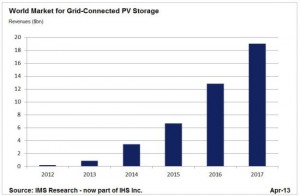 A new report from IMS Research shows that the energy storage market in 2012 was below $200 million and is forecasting that it will grow 100% a year until 2017 where it will be worth $19 billion. Global capacity is set to hit almost 7 gigawatts. This comes as Germany’s subsidies on solar storage systems is set to begin today.
A new report from IMS Research shows that the energy storage market in 2012 was below $200 million and is forecasting that it will grow 100% a year until 2017 where it will be worth $19 billion. Global capacity is set to hit almost 7 gigawatts. This comes as Germany’s subsidies on solar storage systems is set to begin today.
The report titled, “The Role of Energy Storage in the PV Industry” shows Germany leading the charge. As with the feed-in tariffs, it is predicted that the world will follow Germany’s lead with subsidising PV storage systems. The increased uptake of PV storage is expected to spur on more research and development in all aspects of the system, such as manufacturing, and help bring down the costs making it more affordable.
“Eight megawatts (MW) of PV systems were already installed with storage in Germany in 2012, prior to the subsidy being released,” says Sam Wilkinson, PV analyst at IHS, the company that recently acquired IMS Research. “The introduction of the widely anticipated subsidy will quickly accelerate uptake by making the lifetime cost of PV systems with storage cheaper compared to those without it.”
Germany will account for nearly 70% of the worlds PV storage systems this year with other countries set to catch up in the years to follow.
“We do expect that other countries will follow Germany’s example and adopt similar subsidy schemes to promote the use of PV energy storage—particularly where there is a case for promoting self-consumption and grid stability,” Wilkinson said. “Even without subsidies though, storage can be an attractive proposition.”
With many solar power feed-in tariffs now lower than the cost of electricity, it is becoming clear that people need to use the power they produce rather than feed it back into the grid. However, in most places around the world, the sun is not up the whole time power is needed. It is therefore necessary to store excess power generated during sunlight hours for use in the evenings or at times when the sun is not out and power is needed.
Systems of this kind have previously been quite costly to design and install. With Germany starting the ball rolling, solar storage systems are expected to become the logical and more affordable way forward.
